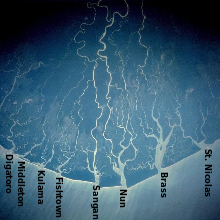
Port Harcourt is the capital and largest city of Rivers State in Nigeria. It is the fifth most populous city in Nigeria after Lagos, Kano, Ibadan and Benin. It lies along the Bonny River and is located in the oil rich Niger Delta region. As of 2023, Port Harcourt's urban population is approximately 3,480,000. The population of the metropolitan area of Port Harcourt is almost twice its urban area population with a 2015 United Nations estimate of 2,344,000. In 1950, the population of Port Harcourt was 59,752. Port Harcourt has grown by 150,844 since 2015, which represents a 4.99% annual change.
The colonial administration of Nigeria created the port to export coal from the collieries of Enugu located 243 kilometres (151 mi) north of Port Harcourt, to which it was linked by a railway called the Eastern Line, also built by the British.

The Ijaw people, also known as the Ịjọ people, are an ethnic group found in the Niger Delta region in Nigeria, with primary population clusters in Bayelsa, Delta, and Rivers. They also have significant population clusters in Edo, Lagos, Ondo. and small parts of Akwa Ibom.
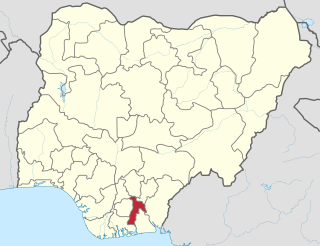
Abia is a state in the Southeastern region of Nigeria. The state's capital is Umuahia and its most populous city is Aba.
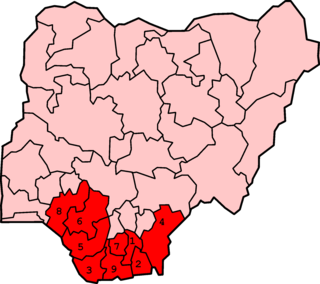
The Niger Delta is the delta of the Niger River sitting directly on the Gulf of Guinea on the Atlantic Ocean in Nigeria. It is located within nine coastal southern Nigerian states, which include: all six states from the South South geopolitical zone, one state (Ondo) from South West geopolitical zone and two states from South East geopolitical zone.

The Ogoni is an ethnic group located in Rivers South-East senatorial district of Rivers State, in the Niger Delta region of southern Nigeria. They number just over 2 million and live in a 1,050-square-kilometre (404-square-mile) homeland which they also refer to as Ogoniland. They share common oil-related environmental problems with the Ijaw people of the Niger Delta.

The Eastern Region was an administrative region in Nigeria, dating back originally from the division of the colony Southern Nigeria in 1954. Its first capital was Calabar. The capital was later moved to Enugu and the second capital was Umuahia. The region was officially divided in 1967 into three new states, the East-Central State, Rivers State and South-Eastern State. East-Central State had its capital at Enugu, which is now part of Enugu State.

The current conflict in the Niger Delta first arose in the early 1990s over tensions between foreign oil corporations and a number of the Niger Delta's minority ethnic groups who feel they are being exploited, particularly the Ogoni and the Ijaw. Ethnic and political unrest continued throughout the 1990s despite the return to democracy and the election of the Obasanjo government in 1999. Struggle for oil wealth and environmental harm over its impacts has fueled violence between ethnic groups, causing the militarization of nearly the entire region by ethnic militia groups, Nigerian military and police forces, notably the Nigerian Mobile Police. The violence has contributed to Nigeria's ongoing energy supply crisis by discouraging foreign investment in new power generation plants in the region.
The Niger Delta Development Commission (NDDC) is a federal government agency established by former Nigerian president Olusegun Obasanjo in the year 2000, with the sole mandate of developing the oil-rich Niger Delta region of Nigeria. In September 2008, President Umaru Yar'Adua announced the formation of a Niger Delta Ministry, with the Niger Delta Development Commission to become a parastatal under the ministry. One of the core mandates of the commission is to train and educate the youths of the oil rich Niger Delta regions to curb hostilities and militancy, while developing key infrastructure to promote economic diversification and productivity.
The Niger Delta Congress (NDC) is a socio-political organization of the ethnic nationalities of the Niger Delta region. The NDC was established on 26 December 2019 in Port-Harcourt, Rivers State, to serve the purpose of uniting the minority nationalities of the Niger Delta region as a means to achieving political and economic autonomy for the peoples of the region. The NDC is under the leadership of an executive council that comprises representatives of the different nationalities that make up the region. The current executive of the NDC which is in acting capacity is led by Nubari Saatah as President, and Mudiaga Ogboru as its National Spokesperson.

The Nigerian National Assembly delegation from Rivers comprises three Senators representing Rivers East, Rivers West, Rivers South East and thirteen Representatives representing Degema/Bonny, Okrika/Ogu-Bolo, Asalga/Akulga, Ahoada West/Ogba-Egbema-Ndoni, Port Harcourt 1, Ikwerre/Emohua, Khana/Gokana, Etche/Omuma, Tai/Eleme/Oyigbo, Abua-Odual/Ahoada East, Obio/Akpor, Port Harcourt 2, Andoni/Opobo/Nkoro.

The Kalabari are a sub-group of the Ijaw people living in the eastern Niger Delta region of Nigeria. Originally, they were known as the Awome. The name Kalabari was derived from their ancestor Perebo Kalabari who was a son of Meinowei. Their original settlement was spelt as Calabar by the Portuguese which was pronounced Kalabari. This settlement (town) was abandoned as the people moved to other fishing settlements. Portuguese settlers continued to maintain the name Calabari which became surrounded by the Efik people of Duke town. When the British came the word Calabari was pronounced as Calabar (Kalaba) instead of Kalabari. At this time the original Ijoid Kalabaris had moved to a new location which became the new Calabar territory since the old Calabar is occupied by different people. Old Calabar became an Efik town with time which has the name Calabar.
Dẹgẹma is an Edoid language spoken in two separate communities on Degema Island in the Niger Delta, Nigeria, by about 120,000 people, according to 1991 census figures. The two communities are Usokun-Degema and Degema Town in the Degema Local Government Area in Rivers State. Each community speaks a mutually intelligible variety of Dẹgẹma, known by the names of the communities speaking them: the Usokun variety and the Degema Town variety. Both varieties are similar in their phonological, morphological, syntactic and semantic properties.

The Ikwerre, natively known as Iwhuruọnha is an ethnic group in Rivers State, Nigeria. The Ikwerre People in Rivers State, spans over four Local Government Areas; Port Harcourt, Obio-Akpor, Ikwerre, and Emohua.
The Engenni people live in the Niger Delta region of Nigeria. They are among the many sub Ijaw groups but they speak a language which linguistic scholars have described to be Edoid. They live in close proximity with other Ijaw people. They primarily live in Ahoada west local government area of Rivers state, Nigeria. Although they consider themselves to be Engenni, the Engenni speak an Edoid language. Alagoa (2003) said: “---The penetration of the Niger-Delta by Edoid groups extends to the Epie-Atissa and Engenni of the central and Eastern Niger-Delta----The Epie, along with the Ogbia and other groups of the central and eastern Niger-Delta, are historically united with the Ijaw.” The other groups of the central and eastern Niger-Delta which Professor Ebiegberi Alagoa said that were historically united with the Ijaw, include the Engenni, as shown from his narrative above. The Engenni have close relations with neighbouring Ijaw tribes such as the Zarama and Epie-Atissa.
Elections in Rivers State are supervised and conducted by two major electoral bodies, Rivers State Independent Electoral Commission (RSIEC) and the Independent National Electoral Commission (INEC). There are 23 local government areas, 319 electoral wards and 4442 polling units in the state. Elections for Governor and the House of Assembly are held every four years, along with federal elections for President and the National Assembly.

Orashi River, is a river of the lower Niger River basin, and a tributary of Oguta Lake, southeastern Nigeria. Urashi takes off, 183 m above mean sea level, from the rocks in Ezeama community of Dikenafai, Imo State. Described as a lifeline to Ideato South communities, Orashi stream serves as an all purpose river for drinking, washing and many others to communities such as Umulewe, Umuchima and Ntueke in the area.

The following is an alphabetical list of articles related to Rivers State, Nigeria.
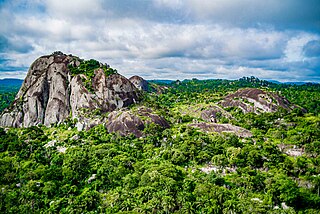
The South South is one of the six geopolitical zones of Nigeria. It designates both a geographic and political region of the country's eastern coast. It comprises six states – Akwa Ibom, Bayelsa, Cross River, Delta, Edo, and Rivers.
Harold Jenewari Dappa-Biriye was a Nigerian politician who was a former chairman of the Niger Delta Congress and was known for his advocacy of minority rights in Nigeria. He was also a former chairman of the Nigeria National Council of Arts and Council and it was during his tenure, the first festival (NAFEST) was held. An arts patron, he promoted events such as Bonny war canoe regattas.
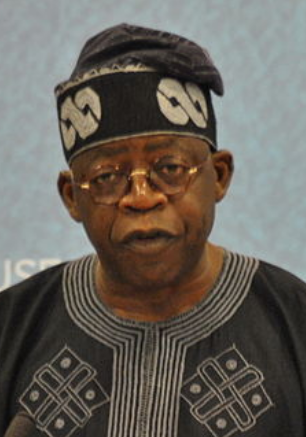
The 2023 Nigerian presidential election in Rivers State will be held on 25 February 2023 as part of the nationwide 2023 Nigerian presidential election to elect the president and vice president of Nigeria. Other federal elections, including elections to the House of Representatives and the Senate, will also be held on the same date while state elections will be held two weeks afterward on 11 March.







